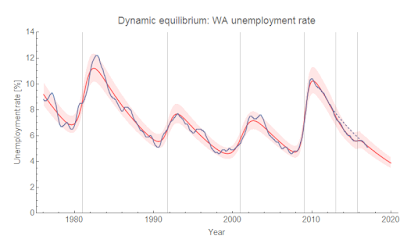I live in Seattle and the big thing in the national news about us is that we raised our minimum wage to $15, which just went into effect for large businesses in January of this year. According to many people who oppose the minimum wage, this should have lead to disaster. Did it have an effect? Let's try and see what the dynamic equilibrium model says. I added a couple of extra potential shocks after the 2009 big one:
People who believe the minimum wage did negatively impact could probably see the negative shock centered at 2015.8 as evidence in their favor. However, that could also be the end of whatever positive shock centered at 2013.0 (which I think was hiring associated with the ACA/Obamacare). I showed what the path would look like if those shocks (positive and negative) were left out using a dotted line. If it was the minimum wage, it would have to be based entirely on expectations because it is being phased in (not reaching $15/hour for all businesses until 2020):
However those expectations did not kick in when the original vote happened in June of 2014, so it must be some very complex expectations model. In this second graph I show what the graph looks like in the absence of both the 2013 and 2015.8 shocks (shorter dashes) as well as just the absence of the 2015.8 shock (longer dashes). Various theories welcome!


No comments:
Post a Comment
Comments are welcome. Please see the Moderation and comment policy.
Also, try to avoid the use of dollar signs as they interfere with my setup of mathjax. I left it set up that way because I think this is funny for an economics blog. You can use € or £ instead.
Note: Only a member of this blog may post a comment.